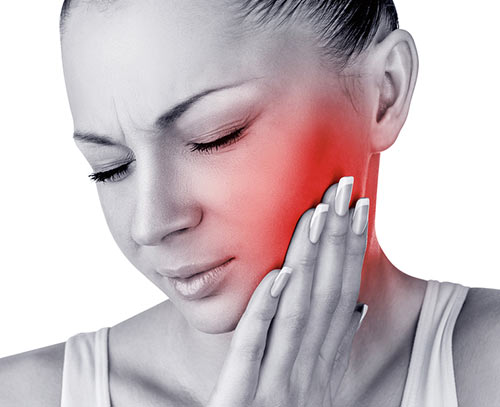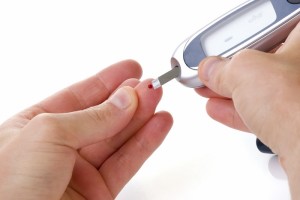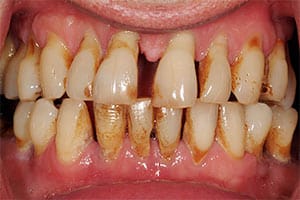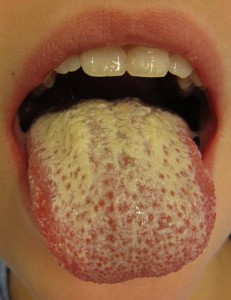Uncategorized
Bruxism
Bruxism is a term used to describe a condition that includes teeth grinding and or jaw clenching. This bad habit is very common and it affects a wide number of adults and children. Teeth grinding can happen at any age and it is usually accompanied with the rhythmical clenching of the jaw. If this happens only occasionally it shouldn’t cause any serious problems. But if it happens on regular basis, the consequences will be more severe. There are two types of bruxism, one that happens while patients are awake (awake bruxism), while the other one happens during sleep (sleep bruxism).
Knowing about bruxism, the symptoms, and the early diagnosis can be very important in improving the outcome of the therapy.
What are the Symptoms of Bruxism?
A lot of people are not aware that they are suffering from bruxism. That is mostly because it happens during sleep and it doesn’t show any symptoms for a long time. That way patients are not really aware of what they are doing during the night. In most cases, other people such as wife or husband, hear the sounds of clenching when they accidentally wake up at night. Since patients do it unconsciously, in the morning they wake up with a sore feeling in the jaws and teeth. It can also happen in daytime, when it is associated with stress, lifting heavy objects or doing other tasks.
Knowing the symptoms of bruxism can be very important. If the disorder is mild, it usually doesn’t cause any problems. The thing with bruxism is that patients become aware of it, once the changes become more serious and irreversible. If you are familiar with the signs and symptoms, you will know when to seek for further dental help.
Headaches and facial pain are the most common symptoms that can point out to teeth grinding. These patients experience three times more headaches compared to the ones that do not suffer from bruxism. In the beginning, the headaches cannot be connected with this condition, and it can be very hard to properly diagnose it.

Facial pain is another sign that you might be suffering from teeth grinding. You will feel a sharp pain located in the temporomandibular joint, earache, sore and painful muscles and more. With time, facial muscles can become enlarged. When they wake up in the morning, people usually experience pain in the area of the joint, and unfortunately, that can lead to several TMJ disorders.
Teeth do suffer a lot of damage from the pressure and force during clenching and grinding. Most of the patients notice their worn-down teeth and that is the moment they decide to visit the dentists. Cracks and chips can occur. The damage cannot be reversed, and if the condition is not treated the loss of tooth substance will continue to happen. In more advanced stages, teeth might become mobile and some patients even lose their teeth.
What are the Causes of Bruxism?
There is a variety of factors that can lead to bruxism. There isn’t any strong evidence that point out to only one reason, or completely explain the process. The latest research strongly associates bruxism with sleep problems, stress, medication, alcoholism, and smoking. There is also a theory that connects teeth grinding with genetics. In other words, it can appear more frequently in one family compared with another.
The first and most important one is stress. Stress and anxiety are a part of the everyday life, and play a big role in a lot of diseases and health disorders. Unfortunately, it can be really hard to influence on this factor or eliminate it, since it doesn’t only depend on us. We are affected by the environment at all times, and that can have a big impact on bad habits such as teeth grinding and jaw clenching. In most cases, people aren’t aware that they are suffering from this condition, and when they are- they don’t associate it with stress. People that work in stressful work environments are constantly under some type of pressure are more likely to develop this disorder.
Bruxism can also happen as a side effect to several types of medication. Certain antidepressants are known to lead to this disorder. The one that is placed high on the list is the selective serotonin reuptake inhibitor (SSRI). Sertraline, paroxetine, and fluoxetine are several examples of this type of antidepressant. Common drinking and smoking are strongly related to this condition. Also, many types of drugs are known factors that cause bruxism.
Sleep disorders such as sleep apnea, snoring, violent dreams, hallucinations can lead to teeth grinding. Obstructive sleep apnea is a very common disease that should be taken care of in time. Sleep paralysis is also commonly associated with teeth clenching.
Unfortunately, your favorite caffeinated drinks might be causing you to clench your jaws and grind your teeth. Overly-consuming coffee and tea can lead to bruxism. We are talking about six and more cups a day.
Aggressive people, overachievers, people that are easily affected by anxiety do show the tendency to develop bruxism more often. Also, patients that are suffering from mental diseases such as Alzheimer’s and Parkinson’s might show symptoms of jaw clenching. ADHD, dementia, epilepsy might also be connected with this conditions.
How to Treat Bruxism?
The treatment mostly depends on the severity of the case. The first step, just like with any other condition is to find the reason that provokes the clenching and grinding. The dentist will be able to help you determine the factor and advise you on how to reduce or eliminate it. If it is stress, then there are numerous relaxation techniques that you can try. They will reduce the anxiety levels and help you relax and sleep much better. Stress management therapy is another way to go. Yoga and meditation can be extremely helpful. Massage, listening to music, cognitive behavior therapy, reading, are also options to look at.
The damage that has been caused to the teeth should be taken care of immediately to prevent any further complications. All of the lost substance should be repaired. It mostly depends on the amount. If there is only a slight loss, it can be done with fillings, if not crowns and bridges might be necessary.
Mouth guards and mouth splints are prescribed for patients to wear while asleep. They significantly reduce the forces that do the damage. These guards and splints will even out the pressure and protect your teeth and joint. They are not a solution to the problem, but these appliances will ease the symptoms and probably prevent further damage.
All of the bad habits such as smoking, excessive drinking, and drug use should be at least reduced. The same thing applies for caffeine intake.
Diabetes and Oral Health
Diabetes is becoming one of the most common diseases in the world. Unfortunately, every day there are thousands of new people diagnosed with it. This is a condition that prevents your body to properly process sugar. There are two types of diabetes, and both of those lead to high blood sugar levels. The disease affects many parts of the body and damages different organs. It can cause problems with the kidneys, eyes, heart and even the mouth. A lot of people are not aware they are suffering from this condition and ignore the many warning signs. Also, the ones that are already getting treatment don’t understand the effects diabetes can have on the oral health.

What are the Oral Symptoms of Diabetes?
One of the first symptoms of this disease is a dry mouth. It is caused by a reduced salivary flow and it leads to a burning sensation appearing in the mouth and tongue. The xerostomia can be caused by some of the medication that patients take. This sensation is especially strong in people with uncontrolled diabetes. The tasting sensation might also be altered due to the lack of saliva. Other symptoms include a higher caries incidence, gingivitis and periodontitis, bad breath, bacterial and fungal infections and more.
Diabetes and Gum Disease

Diabetics very often suffer from problems with their gums. It all starts as gingivitis or an inflammation of the gums. They appear as red, swollen and bleed spontaneously or when brushing. This is a result of poor oral hygiene or uncontrolled diabetes. If patients notice these signs they should pay a visit to their dentist. There, they will get the proper advice on how to treat the inflammation. Luckily, this is a reversible condition that can be stopped with the appropriate measures.
If the gingivitis is not treated it will progress to periodontitis. This condition affects the supporting tissues of the teeth and the surrounding bone. It is the most common oral disease and patients with diabetes are unfortunately more susceptible to periodontitis. The ones that have uncontrolled levels of blood sugar are at a greater risk of being affected. People with diabetes have trouble with fighting the bacteria responsible for the gum inflammation, therefore need to pay much more attention to their oral health and hygiene.
If diabetics don’t visit their dentists regularly and don’t have that ideal oral hygiene, the periodontitis will progress to advanced stages. That is when the advanced loss of bone and tissue happens. Periodontal disease is a complication of diabetes, but also once it’s present it complicates the process of controlling the disease. The severe periodontal disease causes an increase in blood sugar. In the same time, the body is much more susceptible to infections and has less power to fight bacteria.
Diabetes and Fungal Infections

Oral candidiasis is a common opportunistic fungal infection associated with diabetes. It is caused by Candida Albicans and it usually appears in moist and warm areas of the body, including the mouth. With diabetics, thrush can appear as a primary infection in the mouth, but it can also occur as a secondary one, due to xerostomia or use of antibiotics.
Unfortunately, people with diabetes are more likely to develop oral candidiasis. The reason for this is the high levels of blood sugar. As with any other complication, uncontrolled diabetes has greater chances of oral infections. Another very important factor is the weaker immune system that diabetics have. Smoking, dentures and poor oral hygiene are the other predisposing factors for a thrush.
The symptoms are characteristic and can be recognized very easily by a dentist. They include white lesions located in the mouth, specifically on the tongue, oral part of the cheeks and the back parts of the oral cavity. Patients might experience a change in their perception of taste and dry mouth. The tongue will be red, and also bleeding might be present. Cracks on the skin at the corners of the lips are very common.
Diabetes and Bacterial Infections
Oral bacterial infections happen very often with diabetics. These patients have a weaker immune system that can’t fight the bacteria the same way a healthy organism would do. Diabetics have a dysfunctional defense mechanism and that causes recurrent infections. Also, wound healing is slower.
Diabetes and Caries
The lowered immune system, the decreased salivary flow, and susceptibility to bacterial infections lead to a higher risk of caries with diabetics.
How to Take Care of Your Oral Health if You are a Diabetic?
Your care should start with scheduling regular visits to the dentist. Scientists proved that the good oral health can help with controlling the levels of blood sugar. These two have a very close correlation. If you are taking really good care of your teeth and gums that might prove very useful in regulating the disease.
First of all, if your blood sugar levels are under control, you shouldn’t be experiencing any problems. That way your body will be stronger and able to fight any type of bacteria or fungi that can cause an infection. You will be advised to brush your teeth at least twice a day with a soft-bristled brush, and floss once a day. If you are wearing dentures they should also be cleaned every day. Aside from this, professional care will be required. Deep cleanings, fillings, and other regular procedures should be performed if necessary.
Implementing the proper diet that will help you have the disease under control is another important thing. Smokers should tend to quit that bad habit. Exercising and physical activities are highly recommended.
You should schedule visits for at least twice a year. If you notice any weird symptoms, sensations or feelings you should immediately call for an appointment. Infections are very common and should be treated as soon as possible, otherwise, the complications will be hard to treat. That is why you should make oral hygiene and regular dental visits your priority.
Galvanism: What is it?
Ever heard of the word Galvanism or Galvinism? This name stems from the work of Luigi Galvani, the Italian scientist. A phenomenon that refers to the electrical current produced by the interaction of ions when various metals come in contact with each other.
This is an important concept in the field of dentistry. Dental galvanism may occasionally occur when dissimilar metals used in teeth fillings come in contact. This is especially true when individuals chew or clench their teeth.
In modern dentistry, there is a wide array of materials used. One of the most commonly known restorations is silver amalgam fillings. As silver is a major component of these dental fillings, many other metals are included in their composition to enhance strength, ease of handling and stability. Definitive crowns (which are also called caps) can be made of silver, gold, palladium, nickel or other alloys.
While Galvanism is usually not an issue between adjacent teeth on the same arch, this manifestation occurs when teeth with restorations composed of dissimilar metals on opposite arches come in contact. Though this is a rare occurrence, you will find it quite striking should it happen to you.
Over the years, patients often describe the sensation of Galvanism to chewing on tin foil or, in more extreme cases, like experiencing electric shock radiating within the oral cavity. The current produced in dental Galvanism is propagated through the restoration in question directly to the nerve of the tooth. While it is not a serious situation with long-term health consequences, therefore, patients should take heed about these things.

You may be wondering what can be done when you have a sensation as a result of Galvanism in your oral cavity. The dental practitioner can provide some options to correct this problem in your mouth. If a stainless steel provisional crown is the culprit, it can be remade with acrylic or other temporary materials to resolve this issue. Occasionally, you will need to have a replacement situated with another kind of material or the restoration type. If the situation occurs due to two crowned teeth touching in your bite as the offending circumstance, either one or the other will need to be replaced.
This, however, has been very rare in dental clinics, even when you ask around, most dentists have never personally had to replace a crown because of Galvanism. The reason being, there are excess of crowns than not that are made with metals have porcelain baked onto them for beauty purposes, and those that are fully metal for areas where your bite might predispose overlying porcelain to fracture are customarily made of gold and so are compatible with each other.
In conclusion, diagnosis is the first step to correcting signs and symptoms of galvanism within the oral cavity. Patients should be educated enough to identify the electrifying sensation in the mouth and seek professional consult.







